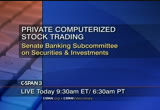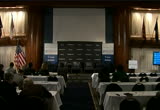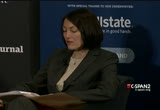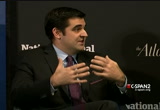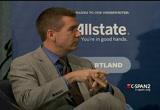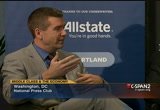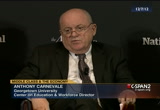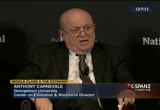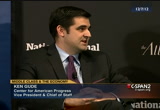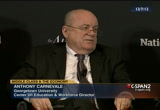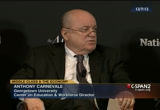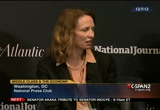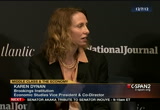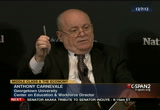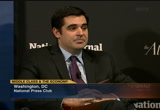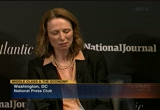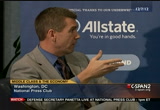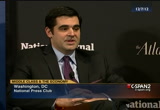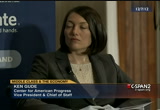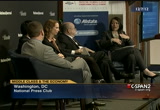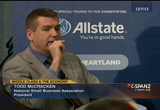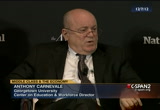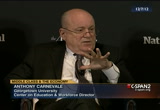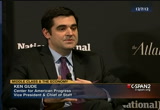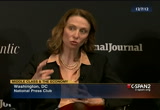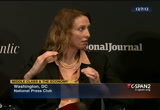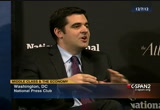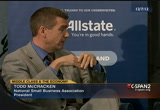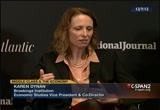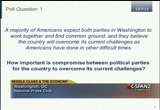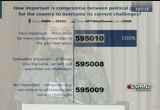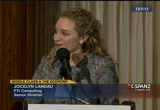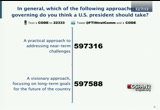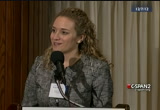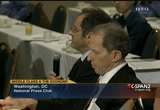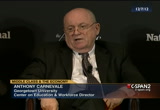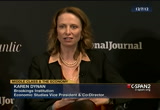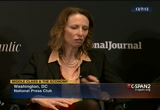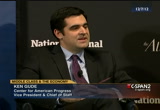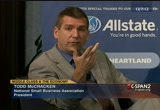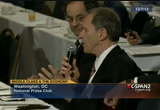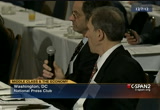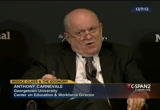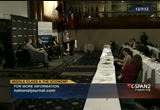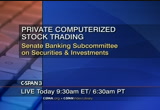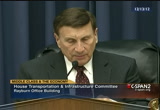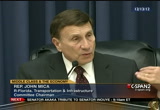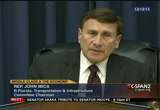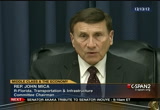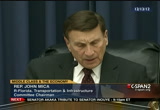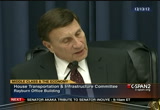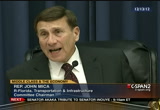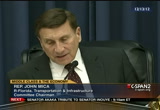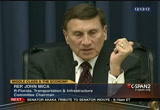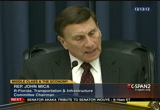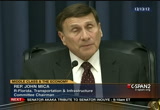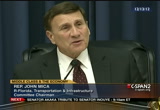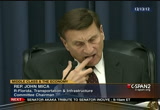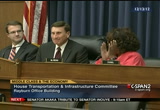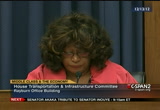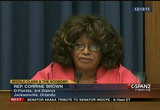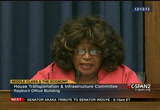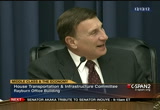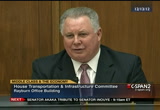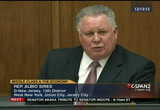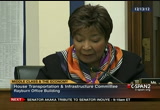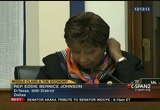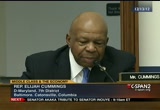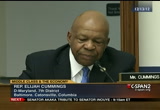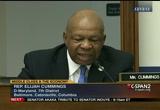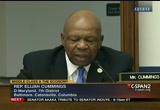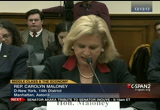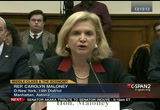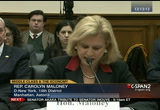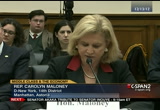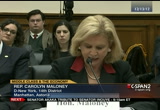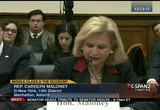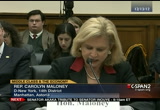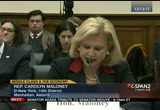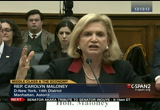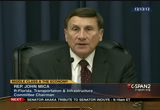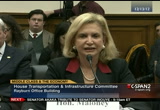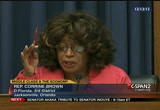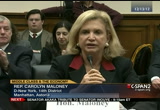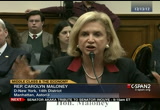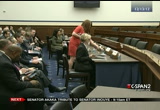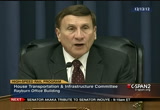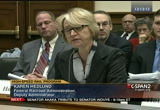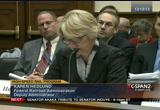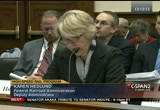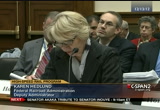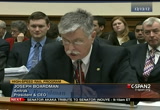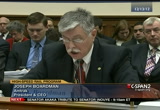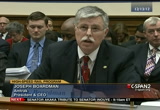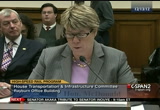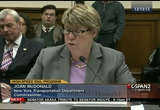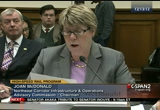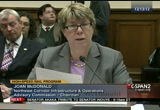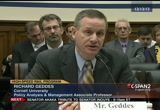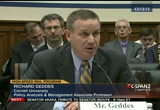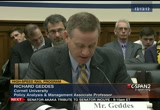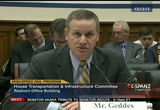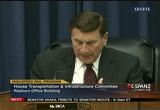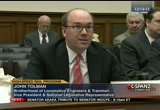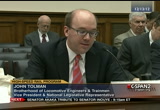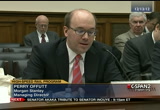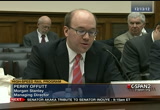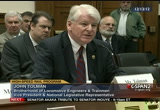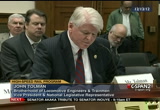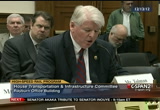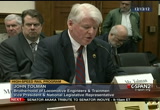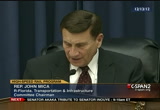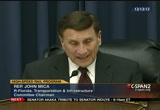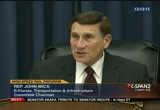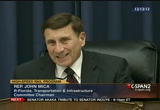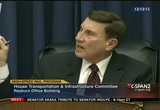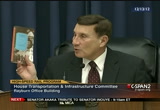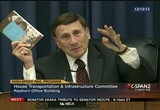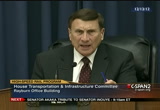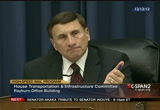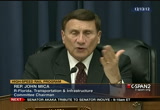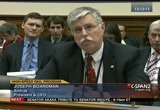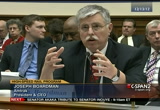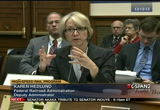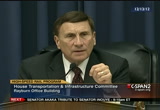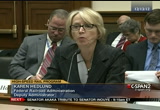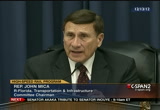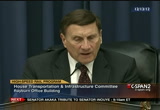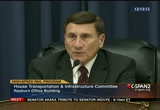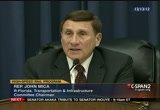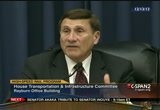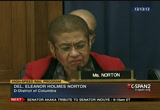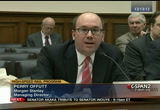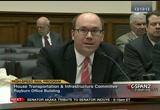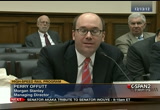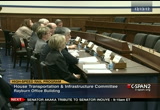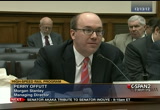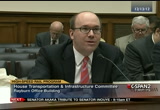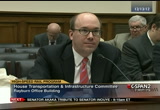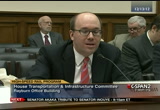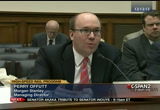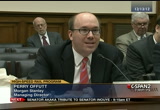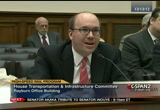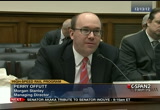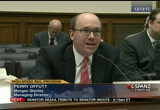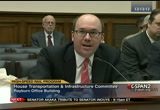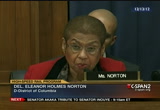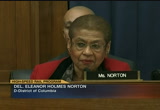tv Today in Washington CSPAN December 18, 2012 6:00am-9:00am EST
6:59 am
7:00 am
hearing -- i am sorry -- official committee room photo of the committee and noticed one askew, but we will reschedule latch, and if votes are cancelled on monday, which i don't know if they have made that announcement but if they do we will probably shift the official photo to wednesday morning. folks may not come back until tuesday and probably at 10:15 because there's a republican conference and democratic caucus from 9:00 to 10:00 and make certain everyone is notified. in addition not like to the members in the official photo if we could have staff from both sides of the aisle to join us for one of the photos so that we can include them in one of the photographs. and take more than 5 or 10
7:01 am
minutes to get that done but we would like to invite everyone and put everyone on notice that we will try to get triple notification out to everyone for that. this hearing is a continuation of the last full hearing of the committee, please to have chaired the committee during the past 20 some months and focus on our transportation needs and requirements. the very first hearing that i held as chairman was january 27th. it was a field hearing in grand central station and it focused on the same issue, development of the northeast corridor and high-speed rail. this hearing is also part of a series of hearings that examines the operations of our primary transportation long distance and
7:02 am
high-speed carrier which is amtrak and as you know, i have been one of the most vocal critics of amtrak and its operation but guy consider myself one of the strongest proponents of high-speed rail, inner-city passenger service, commuter and mass transit in the congress and in the united states but what we want our projects that make sense for the taxpayers, what we want our projects that operate where we have the greatest need and the lowest subsidization by the federal government for those activities but today we will focus almost entirely on the northeast corridor where we started comment and let me make a few comments about that. first, i have to say that the
7:03 am
history of amtrak, attempting to provide high-speed rail in the northeast corridor, has been sort of a horrible history and maybe i can highlight some of the problems we have had. i don't want to just focus on the problems we have had but you have to learn by your experience. first, the original intent to develop high-speed rail, we came up with the a solo project, we had regional service in the northeast corridor, in the area from washington d.c. to new york and boston. and let me say i think it is absolutely critical that we develop that corridor. not only the regional interest but the national interest. we have the highest concentration of population, the
7:04 am
most sophisticated delivery system and interconnection, we have light rail, subway, metro, connectors all up and down the corridor so that high-speed rail is not something that will run by itself as opposed to last week where we heard about the major red ministrations effort to produce high speed, they're doing it between bakersfield and fresno, california where there are very few people, their contention is long-term connected in population centers in san francisco and los angeles, but it will be a long time before that is accomplished. right now we do have the connectivity we need to, the population, and we also have the only corridor, 430 some mile corridor almost entirely unknown by amtrak, the american people and the taxpayers. that is opposed to the rest of
7:05 am
amtrak service, 20,000 miles of service, long-distance, inner-city service, on which amtrak runs on private freight rail that is maintained and paid for on a lease basis to the private sector, and we in fact again bones this corridor and we have also highlighted -- i took the chairmanship in october of 2010, the summary of the title is the federal government must stop sitting on its assets. the first part deals with gsa and we have taken on gsa and some of the idle buildings that sat vacant. was a few minutes ago to continue the effort to get empty buildings fill. if you read through this report
7:06 am
it also talks about the northeast corridor which is one of the most valuable assets, transportation, infrastructure assets in the entire world, not just the united states and is an asset we are sitting on that the taxpayer -- it probably never will be developed to its fullest potential by amtrak. the federal government has trouble operating a two car train set let alone a developing corridor with incredible real-estate and development potential and as a transportation and communications corridor but this outlines again part of our goal was to take this asset, turn it into a valuable return and transportation system for the american people. so we did our first hearing jan.
7:07 am
27, 2011. we had heard at that time the plans by the administration were to spend -- they had developed these in september of 2010, they were going to develop the northeast corridor, it was going to cause $117 billion and take 30 years. the most recent projection that we have, and part of this hearing is to focus on where we stand with that effort to move forward and making this truly high speed, they are looking at $151 billion and also 30 years. my premise is that it can be done in the third of the time and probably much less cost. you will hear amtrak come forward in a minute and tell you how their writers it is over the top, thirty-one million something like that. we probably have that many
7:08 am
passengers in the d.c. metro system in one month. they will also tell you the success of the northeast corridor. the figures we have from their reports, the northeast corridor had 12.9 million riders in 2000 comment and 2012 recently released figures and this is on the fiscal year, not the annual year, 11.4 million writers, most of the increase has been in the state partnerships and other partnerships rather than again totally the northeast corridor. the northeast corridor, their projections are right, i looked at their study, predict you could have as many as forty million riders in the northeast corridor, which is the number of times more than we currently have. unfortunately the train runs about 84 miles an hour average.
7:09 am
they will tell you they can get up to speed the 150 or 160 miles per hour. that is not high speed the way it is calculated. average miles per hour. the minimum actually under u.s. -- of we have a standard -- 110. almost every high speed train in the world is running today at 130 some, 50 miles per hour average and we are in the dark ages as far as -- you will probably hear from ms. maloney and a few minutes, a segment from new york to boston is around 68 miles per hour average. pitiful. i started to talk about the horrible history highlights of amtrak's attempts to get into high speed rail. they did acquire train some
7:10 am
years ago, the acquisition was a total disaster. there were extended expensive lawsuits that went on and on, they required a european design, and european fleet model that was allowed to tilt because you could get faster speed and curves and other things that could enhance the speed. unfortunately amtrak and the way it handled first the acquisition and then the redesign of the equipment, redesigned the vehicles so they were wider and they miscalculated because when the train got a higher speed and tilted the wider trains would hit. to compensate, they had to put the metal things into the expensive high-speed rail tilt trains that they bought so that they wouldn't tilts so that was
7:11 am
the beginning of the fiasco. unfortunately the failure went on and on for about half a year. we close down most of the operations because they didn't have brake parts. they bought equipment for which they didn't have parts, and again, another sad chapter in their acquisition and operation and ability to operate and maintain any semblance of inner-city passenger service in that corridor. they will tell you that they do make money but they don't tell you most of the capital that we provide from the congress and the subsidization and the stimulus money has been spent for capital improvements. i defy anyone who is in business
7:12 am
to not include some capital cost in your expenses. that is part of the problems that we face. i want to say we have some friends from labor here. i kind of like leaving my position because as chairman, i have had so many items to say grace over and i might as at this juncture i am pleased with the progress of this committee in 20 months, we passed almost every major piece of legislation. we passed the transportation bill they said we couldn't pass and a bill that had 17 extensions, and last night we passed the pipeline safety bill. last night the senate passed our bill that is on its way to the president of the united states
7:13 am
for his signature and we are negotiating reauthorization provisions for fema which is the only remaining item that hasn't been addressed so it is a record that speaks for itself. we have made some progress -- i started to say about labor. i want to tell labor folks that i remain committed to making certain that the benefits, wages, retirement, opportunities, remain constant for our amtrak employees, but their future is in, if you continue down this path with labor leaders, that led our workers on, since i came to congress, we got 29,000 amtrak employees to 19,000 and if you continue down this path i don't
7:14 am
think that is hopeful if we expand the service in the northeast corridor and create through high-speed service it will be replicated where it makes sense across the united states, opportunities for workers will expand, not contract. finally, we have made some progress. we got the designation of the northeast corridor by the administration as a high speed corridor which wasn't done before. we are now undertaking an environmental review. i am hoping we can assist them and we will hear more on the progress of that in speaking this up. we have provisions that were written which i helped author and we need to look at improvements so that we can move forward on an expedited basis not only with environmental review but also with construction operation, future
7:15 am
maintenance of these systems. and finally, please with the progress of the northeast commission. we will hear from them today, they're moving in the direction that we want to make certain we move that timetable forward. the northeast corridor is vital, not only because of the mention i made of ingestion and interconnected the pain that we own the corridor but also the entire country benefits because 70% of our chronically delayed airplane flights emanate from the northeast corridor, and everyone will benefit by having through high-speed rail in that corridor. so with those extended comments and i have to take a little bit of extra time, being chairman you get that caught discretion, that is the bad news.
7:16 am
the good news is you won't have to put up with that again after this hearing. let me yield to my delightful and trusted, wonderful, pleasant colleague and former chair of the rail subcommittee, miss brown, my colleague from florida. >> thank you. i want to sincerely thank the chairman for his service as chairman of this committee. i do know that you really have a deep love for transportation, and i would add the committee and the people in the audience give you a hand for your service. [applause] >> and get i welcome my classmate. we all came together.
7:17 am
miss maloney and mica in the class of '92. i am happy we are having this hearing today but i wish it was on water resources development act which is something we have not dealt with. i held a meeting yesterday between the port of jacksonville and -- to try to find a way to seek navigation at the port. because this committee failed to work on developing this bill those shifts would continue to be endangered and economic development of the porche will continue to suffer. i am pleased the current leadership of this house wasn't in charge when the northeast corridor was forward jenna lee developed because it would not exist today. just like high-speed rail in california, the republicans -- going to impact our nation's
7:18 am
economic development, in a very negative way for a very long time. let's be clear. the republicans are no friend to rail. they have things to say about what others are doing wrong that they never put their money where their mouth is. they only go to eight years of the george bush administration to so focused on destroying amtrak which is clearly still the focus of this republican house transportation committee. there is no plan to improve our rail system, no investment in the new system or even the current system. the bush administration and republicans in congress spend most of their money rebuilding transportation infrastructure in iraq and afghanistan, more money they spent their and right here in the united states of america.
7:19 am
after eight years of this from the republicans, president barack obama committed real money to improve our nation's rail system including the development of high-speed rail and low and behold the same members who did not dedicate 1 since to high-speed rail when they are in charge are complaining that the money wasn't spent the way they want it to be spent. mr. mica's unhealthy obsession with privatizing the northeast corridor has limited support and violates the u.s. constitution. the chairman privatizing language in the investment and improvement act of 2008, no private sector proposal for the northeast corridor and his competition introduced last year determined by the nonpartisan congressional research service to be a violation of the appointment clause of the
7:20 am
constitution that would raise costs on states and commuter authorities and eliminate long distance service. we need truth high-speed rail in the northeast corridor. we need to have a serious conversation about how this should happen and those hearings focus solely on privatizing with the goal of making the administration look bad, needs to stop. i want to welcome today's chairman and thank him ridge joining us and i look forward to their testimony and i yield back the balance of my time. >> i think the gentlelady for her comments. i agree with her first part of her statement rather than the latter part. we have a good report. mr who seeks recognition, mr.
7:21 am
bishop. you are recognized. >> thank you very much. i wanted to say thank you for the hard work of the last 20 months. we may not agree on a lot of things that certainly transportation is important to you. i commend you, you look like you are 30 years old. to summarize the rail, just about every weekend -- this is really important to me. i am a writer and icy how it is all the time, i wish we had superspeed, absolutely. it takes 2-1/2 hours to get to washington d.c.. could we make a lot better?
7:22 am
absolutely. this region, the northern region is a very congested area. and if you really want to see it, drive up once in awhile and get on the georgia turnpike on exit 1 and you will see how you want to get back on the train because it is so congested. i would hope that in the future we can really seriously think about high speed rail. this is a region of the country that generates jobs, and more important than anything else have the ridership to sustain such an investment. so i look forward to working on this committee towards that end i want to thank the people at amtrak who week in and week out do a great job trying to accommodate. could it be better? absolutely.
7:23 am
thank you very much. >> other members seek recognition? miss johnson? >> thank you, mr. chairman hand ranking member brown. the northeast corridor has become the most popular metropolitan area and region in the entire year. and it is essentials for commerce that we are able to move goods and people up and down the eastern seaboard efficiently, but with increased congestion but on our roads and our skies, our current system is reaching its capacity. not only are we currently reaching that capacity but it is estimated that an additional fifteen million residents will live in the already congested
7:24 am
northeast corridor with a 30% increase. it is for this reason that our continuous investment in taxing rail is so essentials. the reason thanksgiving holiday set a record for amtrak ridership with 737,537 passengers. the record ridership brought in $56.1 million to amtrak and 8.4% increase over 2011. the northeast corridor is profitable and serves as a model for what we can accomplish for small investments in infrastructure and other parts of the country. what is unclear to me is why there has been a constant drumbeat to privatize amtrak and starve it of its much-needed funding. as everyone on this committee
7:25 am
knows, funding for infrastructure, whether it is for rail, transit or surface transportation has always come from the public sector and only after we have made significant investment does it become attractive to the private-sector. no one on this committee would suggest it would be a good idea to privatize our roads, and we suggest it would be a good idea to privatize our bridges. yet we come back to this issue again and again with rail. i would suggest a more worthwhile endeavor for this committee would be to check the partisan politics at the door and examine how we can improve and expand all modes of transportation the american people depend upon. i thank you, mr. chair and look forward to the witness's testimony.
7:26 am
i yield back. >> i think the gentlelady. the gentleman from maryland. >> i could not let this moment go by without thanking each chairman for your leadership. you and i have served on this committee for many years and also served on the oversight and government reform committee. and i know that you have worked very hard to bring about a lot of change in our nation to our rail system. we may not always agreeing on those changes and how they should be made but i have a tremendous amount of respect for you and certainly i want to thank you for your service. i also want to thank ranking member brown for her leadership and staunch advocacy for the rail system and particularly amtrak. i could not let this moment go by again without at least expressing some disagreement with you with regard to unions.
7:27 am
unions are very important. it was unions that allowed my parents to raise seven children and former sharecroppers with second grade education in one generation to send their kids to college and allow me to be a member of the congress of the united states of america. it was unions. i will fight in july die for the strength of unions because they do play a very significant role. as a representative from maryland by now how critical the northeast corridor is to ensuring mobility from the mid-atlantic to boston. the corridor is also critical to local mobility in many commuter rail lines. every year eleven million passengers, our constituents ride amtrak in the northeast corridor. ridership that as this committee was told last week is only expected to increase with population growth.
7:28 am
isn't that wonderful? the creation of the service moved us in the direction of high-speed rail, that service is not as bad as we need. we need high-speed rail service and we needed in the northeast corridor. i remind you that this is the united states of america, the greatest country in the world. we should have the best service in the world. i strongly support the vision for high-speed rail set forth by president obama as well as the department of transportation citizen designate the northeast corridor as a high-speed corridor. at last week's hearing i was pleased to hear secretary low could discuss the progress that is being made in the efforts to modernize this infrastructure. had lied amtrak's moves to a business plan that will track appropriate private investment. that said i oppose any proposal that would turn responsibility for the development of the corridor over to the northeast state. development of the court or will
7:29 am
cost billions of dollars and it is unrealistic to think the private sector will make that investment alone. i know my home state of maryland, like the other states in the corridor, does not have the resources available to develop it. last week we heard from the president and ceo of the division of american railroads who argued there should only be one passenger operator and the operator should be amtrak. he stated that amtrak is a leader in safety and security and operation and labor issues and is a great partner for the private sector. of course significant infrastructure improvements are needed all along the corridor to modernize, and the beat and tea, which carries every trade in to washington d.c. from points no. of the city must be replaced. the tunnel is opening 1873 and it is antiquated design limits
7:30 am
train speeds to 3 miles an hour. we can do better, we must do better, this is the united states of america. in an effort to begin the long process that will be required to eliminate this bottleneck i support inclusion of a provision in the 2008 real-estate legislation, directing the railroad administration to work with amtrak to service station, the city of baltimore and the state of maryland and operators since improvement of our rail tunnel alignment through baltimore that will increase train speeds and service reliability. ..
7:31 am
>> we'll welcome our colleague, the honorable carolyn maloney, who represents new york, and we'll recognize her for a statement. thank you, and you're welcome. >> thank you so much, chairman mica, and my good friend and colleague, corrine brown and the members of the committee on transportation and infrastructure for inviting me to speak at this hearing. i am truly honored to be here at the chairman's final hearing, and i want to thank him for his focus on bringing high-speed rail to the northeast corridor and for his support of the second avenue subway. i appreciate that last year's field hearing was held in new york. to begin with, and i would just like to say, mr. chairman, i know this is your last hearing, and i hope you will keep your focus on the northeast corridor, and i would like to challenge you to start a bipartisan caucus of republicans and democrats to
7:32 am
work together on the northeast or corridor, all the affected states and communities. because we know how hard it is to push proposals through congress and to make them happen. i truly agree with your analysis that we could cut this price down a third and that we could cut the time down a third and build it in ten years if those of us who care about it decided to focus on it, and if corrine would help us out who has always been such a great advocate on high-speed rail. so i hope you'll think about that, and i appreciate what you've done already. i just want to begin my comments by thanking the men and women of amtrak, met -- metropolitan transportation authority and all transportation workers who have worked around the clock to restore the services in new york after the terrible flooding from hurricane sandy. it was the worst destruction in 108 years of our transportation
7:33 am
system, but because of their hard work our trains are up and running again. in tough economic times, it is critically important to make needed investments that will modernize our aging infrastructure, advance our mass transit systems and strengthen our communities and work force. high-speed rail can play a central role in helping america keep its competitive edge in a global economy. by comparison to rail systems in the rest of the world, our trains crawl along. as the chairman has pointed out, even our most ambitious plans aren't even anywhere near truly high-speed rail. acela averages only 83 miles an hour while some european and asian trains race by at more than 180 miles per hour. the connection between two major business districts in our country, between boston and new york, it inches along at 68
7:34 am
hours -- miles per hour. and imagine if we could cut that and speed that up how those business districts would boom and expand with a more efficient and productive economy. where once american ingenuity brought rail service through the wilderness from coast to coast, in recent decades the u.s. has systematically failed to invest in the modern rail system. i thank president obama for making high-speed rail a priority. instead of developing energy efficient mass transit, we have allowed our rail system to deteriorate. we're not just lagging, we're not even trying to innovate. that's just not the american way. as a resident of knight, i fully understand the value of access to high-speed rail service along the southeast corridor. it is the busiest rail line in the united states, and it is the only amtrak segment that runs an
7:35 am
operating surplus. it is making a profit. of all the places in our nation high-speed rail makes most sense along the northeast corridor which features the most congested road, the densest population and the most interconnected cities, and it had the ridership to make a profit for the investment in this rail system. from washington to boston, the amtrak stations are located right in the city centers making them more accessible to business travelers and the airports. the northeast region also has the densest population in the country, fully 20% of the nation's entire population lives in just this 2% of our land area in our great country. 70% of all chronically-delayed flights originate in the new york area air space causing delays across our country, and 60% of the northeast region's
7:36 am
road miles are considered heavily congested. last year when florida's governor rejected high-speed rail funding for his state, i urged our president, our mayor, our governor, the new york delegation and other delegations to redirect some of the money to new york. i was pleased hen responded with the help of the chairman and our governor and payor by directing $295 million of these funds to a project that will improve what's called the harold interlocking, a century-old intersection of train tracks where hundreds of trains traveling east and west of new york are sorted out each day in a very confusing and delaying area. located in my congressional district, this project helps eliminate a bottle neck that has plagued train travelers for years. investing in these improvements will help relieve delays and pave the way for high-speed rail from new york the boston. i consider it the first link in
7:37 am
this important, vital rail system. it will create over 9,000 jobs and will boost economic activity in our region by over of half a million or dollars. while i commend this investment, amtrak estimates that at this rate it will take until the year 2014 before the u.s. has high-speed rail. the need for high-speed rail is so pressing today we cannot afford to wait another generation. we used to lead the world in rail. we are now trailing far behind. there is general agreement that public and private partnerships should be included in a larger federal planning strategy for the northeast corridor. amtrak's long-term plan provides a template for joint ventures that is worth discussing. new york's governor has met with the new york delegation and asked us to include public/private partnerships. and the mta which is strapped
7:38 am
for cash as is our state, and i join my colleague, mr. cummings, the states cannot afford this. we don't have the money. so the mta is open to partnerships as long as unions and worker rights are protected and all the rights that have put if place for the protection of workers, the environment, pension and other rights. investing now in world class high-speed rail would pack a double punch. it would create high-paying jobs and spur economic development trout the program. -- throughout the program. we are wrong overdue for high-speed rail, and it's time to put this country on the right track. i thank the committee for drawing attention to the importance of high-speed rail, and i look forward to the day when high-speed passenger rail is operating in the northeast corridor. in closing, mr. chairman and ranking member, if we really support high-speed rail, then projects that we fund have to be successful, and they have to have profitable.
7:39 am
right now the northeast corridor is profitable. it is the only corridor that is profitable in the whole nation. so investing in high-speed rail now would boom. my colleague, congress wan capuano from boston, we both travel from new york to boston. usually a three-and-a-half, four-hour ride. if we could cut that down, it would be a boon to economic development in two important business and employment districts in our great country. so i applaud your attention to it, and i want to be on your team in helping to implement and support transportation p in any way. it's vital to our country. but particularly eye-speed rail. -- high-speed rail. how did the great country, the great united states fall so far behind the rest of the world? how did the most prosperous country, the most innovative country fall so far behind the rest of the world? you can be in paris, and in an
7:40 am
hour and a half be in london riding their high-speed rail. you can move across china throughout their many provinces on high-speed rail. we do not have it. we aren't even close to it in the great united states of america. and if it's going to happen in america, it has to happen with the leadership of you, the leadership of this committee. thank you for listening to me. thank you for all the work that you do for transportation across our great country, and i am welcome to any questions. >> well, thank you. i don't think we'll question you, but i will ask fan mouse consent -- unanimous consent that ms. maloney be granted the court is si to be seated on our panel. you'll have the opportunity to participate if you like. without objection, so ordered. thank you so much for your -- >> thank you, mr. chairman. >> i'll just say two things.
7:41 am
one, you asked about the caucus, unfortunately -- i don't make many pledges, didn't even b pledge to term limits, but that's another story. but i did make a pledge when i first ran not to join caucuses, and i actually spent part of my -- >> working group then. >> -- early part of my career dismantling select committees and things that had grown into piewj bureaucracies, filled a huge building next to us, we took that down. so i can't do that, but i will be focused on two projects, and one will be high-speed rail in the northeast corridor, whatever it takes, and work with you and others in that positive regard. so thank you, and we'll let you go. we're going to have a vote, so we'll turn to our witnesses -- >> may i thank the gentleman and chairman for allowing me to join the committee? i have another committee, and i have a respondent to be asking questions and participating, but
7:42 am
thank you for that honor. if my other committee meeting finishes, i will come back and join you. thank you so much. >> thank for coming to the committee and testifying. >> i did have one question. >> okay, real quick. >> i just have one question, because, you know, i'm 100% in support of high-speed rail in the northeast corridor, and one of the problems, one of the challenges is not just high-speed, it's making sure the train is there at a certain time, you know, making sure it's reliable and it's going to be there every day at 10:00 or whatever time. but the time from i think boston to washington is about eight hours. which is ludicrous. and as you said, that corridor between new york, boston and washington is key. however, part of the problem is that you have so many local communities, and even in your area when we had the hearing in
7:43 am
new york, it's not just amtrak, it's several agencies, several communities this involves. so it's not just that you as big, big government can't come in and say that we're going to do it this way, it's pulling all of those communities together. and what is your -- and you don't have to do it now, but it's just that we can't come in as the federal government and say we're going to do it this way. these communities are already built up. >> uh-huh. i thank corrine for your question. when, when the high-speed money was returned and we discussed it because you were distressed that florida was sending it back, and then i appreciate that, you know, and you were pushing to have it in florida, but your governor made another decision, so we reacted to that. but i went to mta which is the transportation hub and directer in our region and first proposed that they go after getting the
7:44 am
high-speed rail between new york and washington. and they said that would be so difficult because of what you just said. it is extremely built up along the corridor, very, very built up. and they couldn't see how they could build that quickly because of the communities that were blocking it and the fact that we did not own b the rail. they said they own the rail. the federal government and the mta owns the rail line between new york and boston, and that that would be much easier. and they said shift your focus to new york and boston, and with the governor's support and the mayor's support, that's what we did. now, that's why we need exactly what you're saying, why we need a task force or a meeting, i don't care what you call it, of members of congress that are affected by that rail line to get together and make it happen, to get the communities behind it. you know, it goes through many
7:45 am
states x so it would have on toe a collective state-led, members of congress from those states working to help make it happen. but according to the mta, they own a lot of the lines meaning the mta owns it, and the federal government owns it, and it's not as dense. it goes through the countryside, the rail now. it's not going through cities as much. but they said going between new york and washington, you know i'd love to change, cut that time down since i'm on that train every week. >> that's right, that's right. >> but they said boston and new york made sense, would be more economical, there would beless trip dance of already built with up neighborhoods, and i think it's important for those of us who support high-speed rail to have a success. we want it to make money. we want to show america that this is something we should invest in and that it's going to pay dividends back and that we should be building it in every state, and we should be building
7:46 am
it clear across america. but there's certain areas in new york where it's not going to make money because the ridership isn't great. the ridership between new york and boston is packed to the limit every single day. i am convinced if we could build that line, it would make money. i'm convinced. >> i thank the gentle lady. we don't want to get into too much of a debate with a member at this point pause we of do have a large panel of witnesses, and we're going to have votes, so thank you very much. i'll ask the other witnesses if they can begin occupying their seat. we have karen hedlund, and she is the deputy administrator of the federal railroad administration. we have joe boardman, the president and ceo of amtrak as a witness. we have joan mcdonald, chair of the northeast corridor infrastructure operations advisory commission and also commissioner of the new york state department of transportation. we have richard geddes, adjunct
7:47 am
scholar of the american enterprise institute. we have mr. perry offutt who is the managing director of morgan stanley and mr. john tolman who's vice president national legislative representative, the brotherhood of locomotive ending nears and trainmen. i want to welcome all of our witnesses. we're trying to get to as many as we can. they're going to call a vote in a few minutes. so if you have a lengthy statement, it will be submitted by unanimous concept to the record. -- concept to the record. we'd like to have you summarize, and when we finish with everyone, we'll go to questions. thank you so much for joining us, and we'll turn first to karen hedlund, and she is the deputy administrator of fra. welcome, and you're recognized, ma'am. >> chairman pica and ranking member, thank you very much for -- >> pull that up as close as you can. it's a little hard to hear.
7:48 am
>> thank you for inviting me to speak to this committee. and, mr. chairman, i want to say it's a great honor to testify before this committee during its final hearing with you at the helm. you've achieved significant legislative accomplishments during your tenure, and your oversight and interest in rail programs has really strengthened our agency while improving transportation options throughout the country. finish and we look forward to continuing to work with you in the coming session. this morning on behalf of president obama and secretary lahood, i also thank you for this opportunity to discuss our planning and development efforts in the northeast corridor which has been states is one of the most valuable transportation assets in the united states, and the details about these efforts which were called nec future are detailed in my written submission. today as we look ahead we know the northeast region's passenger rail market is as strong and full of potential as any in the
7:49 am
country, but clearly the time has come to plan for and invest in the future of the northeast corridor. and so we're moving forward with a strategy that is focused on both it immediate and long-term needs. we are overseeing a comprehensive regional planning effort, and this multistate transportation planning project is one of the largest ever undertaken in the united states. as we look to invest in next generation of nec services, our initial focus with this planning project is to thoroughly understand the true needs of the market. this is going to be a market-based assessment, and we know from the very beginning what types of rail services will be needed to meet future demand. we're also seeking innovative ways to enhance the overall planning and environmental process. i know that's an important issue for you. so as part of that effort, early this year nec future was accepted as pilot project that aims to better engage
7:50 am
stakeholders and, importantly, all the state and federal resource regulatory agencies early on in the process, and we expect that that will produce significant time savings as we go through the entire planning and environmental process. but we must -- it's important that we continue to invest in all transportation modes, not just rail. but the public benefits of the northeast corridor are central to transportation planning for the following reasons. transporting more people by trains will take pressure off the region's highways and airports which as we all know are both overburdened and out of room to grow. and when targeted to the market, rail is the most costfective -- cost effective, least oil reliant and most environmentally-friend hi mode. our current invest maniments -- investments are modernizing power systems, as has been
7:51 am
mentioned, reducing delays at spots such as the hearld interlocking. we're moving forward with engineering projects to replace some of the most complex and oldest infrastructure, the portal bridge, the susquehanna bridge, and as has been mentioned, baltimore's bnp tunnel. these will be enormous undertakings. but i think we can all agree, in order to position the northeast corridor for future demand, we need a vision, we need a framework that will allow this vision to move forward, one that will provide us with an immediately actionable blue print to guide our actions, and we're going the complete this process with an exhaustic public -- exhaustive public engagement. we've seen what can happen how amtrak's service came gradually to dominate the air/rail market in the region, but we know the demand is -- there's demand out there currently that is up met, and that demand will continue to
7:52 am
rise. and ultimately, we can't meet that demand without a sustains commitment from the federal government -- sustained commitment from the federal government. today it's up to us to rise to that challenge just as we have so many times in the past. and we've been recently reminded of this after hurricane sandy which caused unprecedented damage to the northeast corridor. after around the clock efforts to dewater the tunnels, we saw a crystal clear picture of just how essential the northeast corridor is to both the economy of the region and our way of life. it makes you think. what if alexander cat sat, the president of the pennsylvania railroad, had listened to his critics back in 1900 and had given up digging those two tunnels across the hudson river, tunnels that connect new jersey to manhattan? today penn station accommodates 550,000 passengers a day. that's double the peak passengers that go through the three airports of new york. but in 1900 those tunnels were
7:53 am
called a boondoggle, too expensive, impossible to build. some of the shareholders probably thought he was nuts, but today could you imagine new york without it? well, sandy showed us what new york looks like without it. so it's up to us now to create the vision, to do the planning, to execute the projects that will insure we hold true to a basic promise. as the secretary said last week, that the america we leave for future generations is even greater, even stronger than the america our parents and grandparents left for us. and i look forward to answering your questions. >> thank you. and we'll hold questions. i just have one quick thing. have you read conquering gotham? >> yes, sir, i have with great interest. [laughter] >> okay. i was going to make sure you had a copy, if you didn't. mr. boardman, our amtrak ceo, you're recognized. welcome back. >> thank you, mr. mica, and thank you for your service. one of the other things i'd like
7:54 am
to thank you about is that you've put a focus on this corridor, and i appreciate that. we put a vision out in september 2010, and by january you began to have a hearing. by february of that year, and i'd just like to summarize quickly because i know you want to move through here quickly, we proposed the gateway project to support that vision in high-speed rail. in march we named the u.s. d.o.t. named us as a federal corridor. by may we were awarded $450 million to improve the speed in new jersey on what we call a raceway. by june we were in a situation where we had a peer review by our european and asian high-speed rail operators validating our proposal of next generation high-speed rail. in august we began a business and financial plan with kpmg to understand how we can work the private sector in, how the
7:55 am
public/private partnerships might work many that process. in november the board approved the amtrak strategic plan which included the creation of the investment and infrastructure development business line. in february of 2012, the fra launched the northeast corridor future which was a comprehensive planning initiative to prepare this corridor which was necessary for us to move forward with. by july amtrak was -- and you were there, and we appreciate that -- amtrak was a signature sponsor and a participant in the eighth world congress for high-speed rail, and it was the first to take place in the united states. we also updated and integrated the high-speed rail vision at that point in time with the northeast corridor master plan, and we completed the northeast corridor business and finance plan at that point.
7:56 am
just this past september we, using the scela express equipment, we operated speed tests of up to 160 miles per hour in order to demonstrate we could do those kinds of speeds at several locations along the corridor for improvement. and this morning what i want to tell you is we're not going to add any additional trains or cars to the, to the acelas the way that we had originally planned. they're too expensive, and they were -- also, what we really need to do is replace them with a new set of train and equipment, and our expectation is that we'll have an rfi, a request for information, in february or early this next year to make that happen. i've told our folks they need to get this done by the time i'm 70, and i'll be 64 next week. thank you. >> thank you. and let me now recognize and
7:57 am
welcome joan mcdonald who's chair of the northeast corridor infrastructure operations and advisory commission. welcome and you're recognized. >> thank you, chairman mica. good morning. good morning, congressman adler, it's good to see you, from my home state and members of the committee. the northeast corridor commission was authorized by congress in recognition of the inherent challenges of coordinating, financing and implementing major system improvements that cross multiple jurisdictions. the expectation is as you laid out is that by coming together we are take collective responsibility for the northeast corridor. realizing a bolder vision for the future does require unprecedented collaboration. comprehensive planning is difficult for a system that spans eight states and the district of columbia, supports nine passenger rail operations, supports four freight railroads
7:58 am
and has four separate infrastructure owners. the northeast corridor line, as everyone knows, is one of the busiest and most complex railroads in the world. it carries over 2200 commuter, inner city and freight trains every weekday. these trains carry over 750,000 passengers daily. the northeast corridor must balance acute investment needs just to maintain the safety and reliability of current services with the need to address growing service of demands. hundreds of the corridor's bridges and tunnels are more than a century old, and major portions of the corridor's electric power supply were installed in the 1930s, and echoing my fellow colleagues on the panel, we see what happened with the electric system during hurricane sandy. the fact the commuter and amtrak services intersect at common facilities inevitably means
7:59 am
delays to anyone's service could quickly cascade and adversely effect the on-time performance of all rail services. with major segments at or near capacity, all services that utilize the corridor are increasingly susceptible to service disruptions resulting from infrastructure failures. in january the commission will be releasing a report on the corridor's critical infrastructure investment needs and put to the -- input to the report or was provided by amtrak, the corridor state asks the freight railroads through a collaborative process. while nine states are part of this organization and this commission and we recognize that the assets are in individual states, we recognize that those assets transcend geographical boundaries. it is one corridor. the commission's authorizing legislation directs that we develop a cost allocation methodology for use of the
8:00 am
corridor that insures that there is no cross-subsidization between inner city, commuter and freight rail service. our aim is for this process to set a foundation for increased federal and state investment in the corridor's infrastructure. in return for increased state investment, we are exploring options to address the governance of the corridor to insure that the states are equal partners in the decision-making process. our goal is to have a recommended cost allocation methodology by the end of this fiscal year. we are also engaged in activities examining the long-term rail needs in partnership with the fra's northeast corridor future program. hurricane sandy gave us all a vision into the chaos that would ensue without the vital rail assets that are so critical to the economy of our region. we all watched as our elected leaders prioritized the reconnection of rail service to
8:01 am
get the region moving again. we commend the railroad and transit employees who made heroic efforts to restore these services as quickly as possible. the northeast corridor is a national resource, and along with the i-95 corridor, the transportation backbone of the most region. however, the corridor's current path is unsustainable. the reliability of existing service is threatened by capacity chokepoints and significant state of good repair needs. meeting our future needs due to increasing demand for these services is simply not possible without significant investment and new capacity. in short, the commission is planning for the future at the same time that we are looking to address the very significant challenges that the corridor is facing today. on behalf of my fellow commissioners, in closing i want to extend our appreciation for this committee's strong support
8:02 am
for the northeast corridor, and we look forward to continuing this partnership. in particular, i want to thank you, chairman mica, for your support of the northeast corridor, and we look forward to a continued dialogue with you. thank you. >> thank you. and we'll now recognize mr. geddes, and he is the, an adjunct scholar at the american enterprise institute. welcome and you're recognized. >> thank you, mr. chairman mica. i appreciate the opportunity to be back and speaking to the committee once again, and i just wanted the note that in addition to my affiliation with the american enterprise institute, i'm an associate professor at cornell university in the department of policy analysis and management and that just this semester with a cornell grad, john foote, class of '74 engineering grad, his company developed easy pass. we have started a new program and infrastructure policy at cornell, and i have some information about that. and that is to educate future
8:03 am
generations of students and young people on the important issues that this committee addresses. and i hope to be able to work with the committee in the future and, hopefully, with yourself in developing this program. in fact, i think it's the only one of only two such programs that are currently operational in the united states focusing on infrastructure policy. the other one being at the university of minnesota. so i'd just like to draw everyone's attention to that and seek your advice on that. i want to address a few things regarding the topic that the committee is focusing on today which is the northeast corridor's future and options for high-speed rail development and private sector participation in transportation. there's a couple of key issues i'd like to address, the first is to get a concept on the table that i think is extremely relevant for this debate that is, i believe, absent which is the concept of a residual claim. sounds like sort of an academic
8:04 am
concept, but with i think very important. a residual claim as well as residual claimants. second, i want to be clear about the value that i think private participation in the northeast corridor can bring to the nation in several different ways. and third, i'd like to emphasize that the gains from private participation as judging from a number of economic studies that focus on this, do not come from reducing wages or reducing employment once you get or more private participation, they come from increased value creation and value capture due to the incentives and the skills of the private sector partners that you bring in. i also want to emphasize that through competitive public/private partnerships it's possible for the public sector to realize the value associated with private participation now through an up-front concession payments that we've seen. so the public sector does not have to wait to realize these
8:05 am
benefits. i want to emphasize that a residual claim is defined as a property right to the profits from a given economic activity. that is, who actually has a right to obtain the value that they create from undertaking new efforts in economic activity? this is a key public policy issue for the northeast corridor. the question is, are the property rights to the value creation from additional investment and effort clearly assigned to some well-defined group? i think it's difficult to overstate the importance of this, and i don't think they are at present. one of the key things that private participation does is to introduce clear, well-defined, residual claimants who have a right to capture the value that they create by better using the current assets that we have on the northeast corridor. private participation creates such well-defined, residual claimants. from this fact the impact of
8:06 am
bringing in private participation and residual claim hasn'ts, a number of important social benefits, can be obtained. those include the expertise and skills of the private sector, those include the sharp-focused incentives that you get from private participation that you do not currently have. and they also include access to new types of capital, particularly equity capital which is risk-taking capital that is critical. those, those three aspects of private participation would bring enormous social benefits to increased private participation on the northeast corridor. i want to note also that there's inherent risks, substantial risks in these types of activities that are currently entirely being borne by taxpayers. one of the key benefits of bringing private participants into this situation is that you have people who are experts in bearing risk -- that's a service that they provide, as a risk-bearing service -- and they
8:07 am
make the cost of that risk bearing transparent. i think that's actually an enormous benefit, bringing private participation in. i'll just close by noting that one of the, i think, underappreciated benefits of private participation is the fact that the public sector can realize that value immediately through competitive bidding by competing groups of potential private participants in a number of areas. suppose it's operating a train station, for example, and you can concession that out, receive an up-front concession payment as maryland did on sop of -- some of the i-95 rest stops that i noted in my testimony, and that's one major advantage of bringing in private participation that is not reliant on negativefects on labor. so thank you, mr. chairman, and i'll stop there. >> well, i thank you, and what we're going to have to do, we have a vote going on right now, we have two minutes to get to the floor. so our two panelists, we will
8:08 am
return. i think we can be back here at 11:45. we'll reconvene at 11:45. we'll aeroboth of our -- we'll hear both of our remaining witnesses. so with that, the committee stand in recess for one-half hour. thank you. [inaudible conversations] >> like to call the committee on transportation infrastructure back to order, and we had three votes and now return to the hearing of our witnesses that remain. so we will proceed. it is the designated time that i indicated we would resume, so with that, i'm pleased to recognize the managing director
8:09 am
of morgan stanley, mr. perry offutt. welcome, sir, and you're recognized. sorry about the dray. >> no problem, mr. chairman. thank you for having me. my group -- >> pull that up real close because -- >> oh, sure. hope that's better. thank you again for having me this morning. my group's focus is on working with clients both on the public and private sector, trying to seek out opportunities where private capital can be used to invest in u.s. infrastructure. as a financial adviser focused on this area, i appreciate the opportunity to share my perspective on some of the key considerations that could effect interest from the private sector, both financial investors, construction companies and rail operators in participating in the ce sign, construction, operation, maintenance and financing of a high-speed rail project along the northeast corridor. public/private partnership structures have been used for
8:10 am
numerous construction projects and have demonstrated that the private sector, one, can often build a project more quickly and at a lower cost, two, drive efficiencies over time by introducing technology solutions and, three, develop incremental revenue sources by delivering additional services. while there hasn't been a public/private partnership or p3 transportation involving a u.s. high-speed rail project, there are similar greenfield p3 transactions that can provide a guideline for financing this project. i also belief that there are numerous companies interested in high-speed rail in the u.s. given their experience building and operating high-speed rail systems internationally, specifically in europe and asia. these operators and construction companies would join wedding groups -- bidding groups with financial investors on the right to design, build, operate, maintain and finance this project. after being prequalified, the
8:11 am
winning bidder is usually chosen based on lowest cost. one of the key considerations is that the project generates enough operating cash flow, the private sector would be compensated over time for their investment by receiving the net revenues generated from the project. however, if the project does not generate adequate net revenue, the bidding groups will require an ongoing revenue supplement known as an availability payment. to insure that they'll be able to cover their cost and earn an adequate return on their investment. if the revenues reach a certain level, the availability payments could go away, and the concessionary would only be entitled to the project's revenue. as a result, the payment could be structured as a floor to support investment-grade financing and attract maximum private investor interest. given the existing passenger rail foot print in the northeast and high population density in
8:12 am
key urban areas, the project would be very, would be a very profitable operation. and the private sector could also rely heavily on significant historical traffic information along the northeast corridor and be very confident about their estimates regarding ridership. as i previously mentioned, one of the primary reasons for something into a p3 transaction is to transfer risk of construction and operations to the private sector. however, private investors willal expect some comfort from the government on a few important risks associated with the project. one, how potential cost overruns will be dealt with, especially be they occur as a result of government action. two, insuring some level of protection against government investments in future competing transportation infrastructure. and, three, a'sing the political support -- assessing the political support for the or project at the federal, state
8:13 am
and local levels. thank you very much for the opportunity to testify this morning on this very important topic, and i'd be glad to answer any questions later. >> thank you. and we'll hold questions. i've got now the vice president and national legislative representative of the brotherhood of locomotive engineers and trainmen. welcome back, mr. tolman. >> thank you, mr. chairman, and appreciate the opportunity to be here on behalf of the 36,000 active members of the brotherhood of locomotive engineers, teamsters and over 70,000 rail conference members. i appreciate the opportunity to speak to you, mr. chairman, and for your services to this committee. um, it's truly an honor to me to be here at your last hearing as the chairman of this committee. identify appear -- i've appeared before this body many times in the last several years and always enjoyed your questions and comments, and, you know,
8:14 am
look forward to working with you and members of this committee into the 113th congress. but thank you. today i'd just like to talk about a personal experience as a locomotive engineer on amtrak as well as a blet's position on amtrak's progress and successes in the northeast corridor. also would like to compare to other countries passenger rail high-speed service as they relate to privatization. i was an amtrak engineer operating trains in the northeast corridor in the mid '70s and early '90s. from its inception i remember amtrak being chronically underfunded. i remember amtrak as a young man, i remember coming down here some two decades ago trying to secure some funneling for amtrak -- some funding for amtrak to preserve a safe and reliable rail passenger service and save the jobs of my fellow
8:15 am
employees, all professional and highly-skilled workers. now 20 years later i'm still fighting the same fight. i remember running test trains in the northeast corridor at 150 miles an hour with a 40-year-old diesel and passenger cars that were over 40 years old. i've seen the growth, and i've seen improvements in the northeast corridor from electrification of the main line and improved crossovers for high-speed trains. you know, while positive train control made national headlines the last several years, amtrak has had a form of ptc in the northeast corridor for almost 20 years. all while amtrak's funneling -- all this while amtrak's funding is a traction of that spent on other modes and by other countries. it's, frankly, embarrassing to compare government funding for
8:16 am
amtrak with u.s. government funding for domestic aviation and highways. and passenger rail funding for european and asian countries. to build or maintain one of the best highway systems in the world, we've spent $114 billion and built it over 35 years. in today's dollars it would be $426 billion. but times have changed. congestion on our roads are at historic levels, and by the year 2020 90% of urban interstates will be either at or over capacity. and as anyone who's had the pleasure of knewing recently knows this problem at our airports, flight delays, overcrowding planes. in fact, in spite of all this, amtrak now carries more riders from new york to boston, 50% of all the people that travel this distance. and between washington, d.c. and
8:17 am
new york city amtrak carries more than twice as many passengers as all airlines combined. today it carries 75% of inner city travelers between new york and washington. amtrak has done all this with the threat of funding cuts and privatization, especially of the profitable northeast corridor hanging over its head. we know that in other parts of the world privatization of high-speed passenger rail has been tried and has failed to solve the problems it was intended to solve. these plans were almost always preceded by funding cuts, systemic safety can and reliability problems, caused a great deal of upheaval in transportation and forced countries to renationalize a system. with that being said, we said that amtrak's long-term next gen plan for the northeast corridor provides a template for a
8:18 am
public/private partnership that is worth discussing. if a partnership does not reduce the public interest or the interest of the brotherhood of locomotive engineers' members and amtrak's other professional and skilled workers or. further, the blet beliefs that amtrak should continue to be the service provider for the northeast corridor and across the unite because they have provided progressive, quality service despite many, many obstacles and continue to look for ways to increase train speed, reliability and service in spite of these obstacles. thank you, mr. chairman. >> thank you. and thank all of our panelists, particularly for your patience while we had to exercise our constitutional responsibility, and that's vote. we're back now, finished the panel, and we'll turn to questions. let me just comment to mr. tolman and welcome, too, on behalf of labor representing men
8:19 am
and women that work for us. appreciate your role. as i've said repeatedly and sometimes i wonder if people have a hearing disability, can't comprehend what i'm saying, i've always advocated maintaining the benefits, the salary, the becames, the retirement -- the wages, the retirement for amtrak employees in whatever structure we adopt making certain that's protected. i've also been here and watched the number of personnel from amtrak go from 29,000 to 19,000, and i say that doesn't portend a bright future for labor either if you're the head of a union or labor organization or a member. i've been there fighting for labor when labor had to fight amtrak is and the federal
8:20 am
government for benefits and wages. in fact, that was a prolonged and difficult experience for our, the people who work for amtrak, those union members who were denied benefits and wages and always use the example of freight rail which has taken over which very often gives better salary, better wages and reaches agreements without that type of imposition. and as far as my record, i have always supported the right of americans to join a labor union. when we wrote the tsa legislation, i insisted that we have that right. i also take the position that no, no one should be forced to join or compelled to join a union. but i think that's an important right, and i think that labor has done an incredible job over the years. there have been some problems here and there, but in raising
8:21 am
the standards, the compensation, the working conditions for the people that get out there and roll up their sleeves and actually make things happen rather than like congress, the bureaucrats just talk about it. so want to make that perfectly clear, and as we move forward i think that, again, there are just unlimited possibilities. if we can have four or times the number of passengers, i know we can increase the employment. we already actually technically amtrak is a private corporation. it is, does have some cause is si-governmental characteristics -- quasi-governmental characteristics and certainly governmental support. there have been debates about the level of support, but furthermore, i've always supported long distance service, a national system.
8:22 am
but we want that to be operated and managed on on the very best basis because the chief underwriters of the subsidies of the private sector corporation that we have with amtrak and created in '71, the main underwriters are the taxpayers of the united states. so that's all i've asked or for. and then i think our goal is to have high-speed rail in the northeast corridor. i think that's your goal, mr. tolman, correct? >> yeah. >> you'd support that? >> positively. >> okay. but we wan to do that rather -- we want to do that rather than in 30 years, 30 years to my calculation brings us -- and their chart which we'll put in the record without objection shows us not getting to really high-speed operations until 2030 to 2040. at that juncture, i won't be around to see that, given my dna
8:23 am
and longevity as far as male members of my family are concerned. so my goal is to see it while i'm alive and not to have it happen after i'm pushing daisies out of some better setting. but with those words, questions. you've got, mr. boardman, a -- well, i have to thank, let me go to hedlund first. i brought a copy of "conquering gotham." has everybody read that on the panel? have you read that, boardman? >> no. >> mr. boardman has not. would the taffe please present this copy, and i want to caught graph it for him. [laughter] >> that's how i get books. >> let's see, to joe from john
8:24 am
with love -- [laughter] okay. but if you think you're having problems, after you read this story of alexander's aattempts to bring -- attempts to bring rail service into manhattan, the tunnels that he built, the union station that he built, you think your politics have been tough, wait until you read this story. it's one of the most fascinating volumes i have ever read. and it encapsulates all the issues that we're going through. and he was determined to do this. they were originally going to build another bridge up in the northern part of manhattan to connect up to that time about 10, 12 rail lines went in the major ones, i guess, was the pennsylvania railroad. and then people had to take a ferry from new jersey to, to new
8:25 am
york. and he, his sister was an accomplished artist, mary casat, who had a studio in paris. so in one of his, during his visits he observed the french tunneling. so he came back and said, hell, if we can -- if the french can tunnel, we can too. he actually failed, and you'll read that story in this volume, trying to build the tunnel previous to that. but he did succeed. it's just an incredible story of vision and just the type of determination to get the job done. but the staff, one of the staffers deliver that at this point to mr. boardman, thank you. >> thanks for bringing it up. >> all right, again, it does take that vision and it takes, also, the determination and also, to be quite blunt, it takes the cash. now, i was excited about
8:26 am
president obama committing to high-speed rail. however, i did express my disappointment in that the money was diverted among 150 proms. most of the money went to california for a true high-speed rail, the rest is inner city-enhanced passenger service and a number of other improvements and grants. what is -- for the fra representative and administrator, deputy administrator, what is the intent of the administration for the, for high-speed rail in the future, the next four years? can you -- >> well, i think the president's vision is in his budget, and it includes additional billions of dollars for high-speed rail x. so it is spelled out in his budget. he continues to be quite committed to it, and we hope
8:27 am
that the congress will follow through on that. >> okay. well, mr. boardman, well, and you started out with, i think, less than 100 million, and some of the money that came into the northeast corridor came in sort of, i guess at the same time we designated the corridor high speed which i commend you on doing, but secondly, with the return of money from at least florida, wisconsin and ohio and designated. and, mr. boardman, you're using that in some -- i don't mean this to be critical, but it's sort of a band-aid approach of because you don't have the money, but you're trying to pick projects that would make a major impact and improvements in the speed of that corridor. where are you on gateway as far as funding, planning, execution? what's -- where do you see it now and how much to get it done?
8:28 am
and dateway is -- gateway is, maybe you could describe that, too, for the record. >> sure. gateway is a project that basically goes from just past newark into penn station, new york. it involves two new tunnels, a new portal bridge, some new tracks that go from, basically, lautenberg center all the way to the new two tunnels, and it also includes space within penn station for especially new jersey transit trains that don't have the same ability that long island railroad does to stop quickly and store or their trains on the, in the hudson yards or the west side yards. >> and where are you with that? >> we're in a planning stage. we -- some of the projects could move a little bit quicker than the others, and we included that in the after-sandy request of $336 million. and what we really need to do is make sure we secure a space
8:29 am
under the hudson yards. it's about an 800-foot section at about $190 million. because once that, once that real estate development actually occur, it would close off the ability to get those two new tunnels in. the second thing we really need to do that was going to be done under arc but also would be done under gateway is to raise to a platform or to a different location that sub 41 station that was flooded during the tunnel. and also add high-density signal systems on the east river tunnels. not so much to add capacity to the station, but to give us the ability to move trains through those east river tunnels more quickly, and we could have restored the same level of service quicker had we been able to do something like that. so those are the -- and an additional planning amount of money to move us forward on that project. >> okay, two things. one, we're trying to complete an
8:30 am
environmental study in the corridor. that's scheduled to be done about 2015, is that correct? >> that's right. it's the tier i for the corridor which will set the framework for the entire corridor, and then you go into tier ii, and that process looks at individual projects. some of the drays that occur -- delays that occur or in the environmental process come when the individual projects are considered, and the advantage of bringing the resource agencies in early in the beginning of the planning process is that when we get to tier ii, we can say that we think significant time because the alternatives will have been narrowed, the resource agencies will have bought into that. you won't have them coming in
8:31 am
and saying you have to redo the analysis or looking at two or three different alternatives that were dismissed early on, but they weren't at the table when that analysis was done. so we are hoping to, as i said, complete the tier i by 2015. by the way, we do need additional funding. the first phase of that we had $9 million for. that'll be completed in february. but the next two phases will cost an additional approximately $30 million, and we need additional funding -- >> has that been requested in the budget? >> i believe so, but i'll, i'll get back to you on that. >> let us know on that. also, anything we can do to speed that process up. the other thing is does that include the entire corridor, all 37, or just parts of it? >> it's the entire corridor. >> where -- is it? i was wondering, again, if any of this could be divided up and expedited. and that's something else i'd
8:32 am
like to look at and discuss with you all. i'll have a little bit more time to focus specifically on the northeast corridor after the beginning of the year, and i'd like to make that a priority, moving it forward. but you'll need the money -- >> that's right. >> finish if you're going to complete the plan. then when we get that, we will have alternatives analysis if. >> yes. >> okay. at that point and juncture, now, we had secretary lahood here, and he was talking about overall high-speed rail, and he said we will also need the money. he said he would be open to opening these opportunities to private sector competition. do you see any problem with that? >> no. as he said last week, and i think he's been quite consistent on this, we welcome private sector investment to be able to leverage the limited public funds that are available. we're going to want to make sure that where that money comes in the makes the most amount of sense, is the most costfective
8:33 am
way -- cost effective way to do it, that the contracts are put together in a way that public the public interest. -- that protect the public interest. >> okay. i would concur with all of those. particularly our job is protecting the public interest. also i think it's important that we maintain the ownership of of that infrastructure that we're continuing to build along the way. i think, one, you're never going to get the congress to give you $151 billion even over a period of 30 years, but i think if we could attract private capital, and that's where our managing director of morgan stanley maybe could shed some light. right now we take in about a billion dollars. we have about 11 or 12 million passengers on that run. if that was 40 million passengers, of course, there's costs to not just adding passengers, but capacity and the
8:34 am
infrastructure to support that. how much money do you think could be raised, any thumbnail idea of what, what that kind of activity would support, that revenue? we'd probably have about four billion coming in from passenger revenue at that stage and could be amortized over a number of years. maybe you could tell us what that might foretell or forecast for investment. and you, i think -- well, i foe you said there -- i know you said there have to be conditions, government guarantee and backup which could be done, but with that kind of revenue, what kind of investment would it support? >> sure. thank you, mr. chairman. it's hard to put, obviously, a precise number on this, of course, but what i would say we're in an environment where there is more and more capital
8:35 am
being raised to invest in infrastructure projects globally than there are actual opportunities to invest that. and i say that because there are a lot of projects that really do, are not profitable and are very difficult to make the math work from a business standpoint. the northeast corridor, we believe, i believe, is definitely an exception to that. it's profitable currently, and i think with additional investment could be a lot more profitable. >> well, again, if we have four billion in revenue versus a billion, what would that support? any idea? i mean, you take that to the market -- >> right. >> -- there's a lot of expenses involved, but there's still going to be a nice net return. support 20, 30 billion, 40 in investment? i don't know. what's the -- >> you could. it would definitely come in kind of two forms. it would be private debt capital and private equity capital, and the reason i differentiate that is i think with that it'd type
8:36 am
of cash flow, what people would get comfortable with is when you look at the cash flow that's available for debt service and let's assume after all the costs and all of that that you get to something in excess of, you know, $2 billion of that, you could argue that there's at least, well, basically it's hard to give an exact number, but, i mean, there's clear multiples of that that would get you comfortable for just pure debt service that could come from the markets. these numbers, it's hard to -- there is no other project like this because it's so huge relative to what people have been investing in the -- >> but again, there would be interest, there's capital now seeking projects of this nature, one, of course, of in this magnitude might have a great deal of interest, but we've got -- my main thing is to get the alternatives, get this environmental study done, then look at the possibility and take proposals from the private sector to build this out.
8:37 am
of course, and whoever the operator is or working with amtrak has to also honor the labor agreements and -- >> right. >> so, well, i think, you know, i'm looking at it, trying to look at it from a positive standpoint of what we could do. there's so many benefits, as i said, the air traffic congestion, even with next generation air traffic control which won't be developed in the quickest, i'm trying to speed that up, too, with some things that we're doing, maybe 15 years. you can only fly so many planes so closely together. they can only land so many planes at laguardia, jfk and newark. been there and watched them land and can see that we're maximizing each with the stewart addition of the fourth airport, you still will run out of air space. but taking this traffic to the corridor and then the connections that we have, a
8:38 am
question was posed by ms. brown about, about impeding only of the service along the way -- some of the service along the way. actually, if it's properly done and there is separation, we can enhance local passenger service, commuter service, and we can also increase freight traffic by, again, separation within the corridor with the right plan. so i look forward to working with you, mr. boardman, with deputy administrator and others, and thank you for participating to today. we're going to leave the record open til the 31st of december. how's that for a date, ms. norton? without objection, so ordered. we may have additional questions we'll submit to you. may i yield to ms. norton now? >> well, that's a fine date, mr. chairman. it will either be over the cliff or not by that time. [laughter]
8:39 am
i very much appreciate this hearing. i want to say that i have been an officionado of public/private projects in my, in my own subcommittee on economic development where it's better known, better understood and extensively used. i have -- and that's why i'm very interested in its conceivable application to a railroad. if we did more public/private partnerships in construction and real estate in my other committee, we would have saved billions of dollars. now, i want to see whether or not that's the same if we're talking about railroads. i noticed in mr. offutt's testimony, i'm looking at page 9, that your examples where you recently advised on transactions tend to be examples like parking
8:40 am
systems, concessions, parking concessions, airports and the like. have you ever advised on any prompt -- on any project as large or as extensive as the northeast corridor? >> i'd say there are a lot of projects i've worked on that are very similar, and in terms of airports, there's lots of complexity that are very unique to airports, but i would say this is a are unique project relative to anything that i've seen in the u.s. or around the globe in terms of what the scope of this project could be, especially as it relates to cost. so i think it's not just probably me speaking, it would probably be anyone in the financial community have been used to seeing transactions where an equity check from a large institutional investor of a billion dollars is considered large, and this would be something which could support significantly more than that if structured appropriately.
8:41 am
>> now, you testified that capital is available for investment in such a project like the northeast corridor. now, our recent experience -- i'd like you to describe what you think is the reason for our recent experience where the department of transportation put out requests for proposals, did get a few but none for the northeast or corridor. why do you think we, that the d.o.t. got none for the northeast corridor since that's the only really profitable one? >> one, i'd start with just looking at the example of the florida high-speed rail project which had been considered at one point in time. and there was a list of groups that had formed that were, that expressed interest in that, and they were really true hi kind of some of the best operators around the world for high-speed rail, some of the best construction companies and some
8:42 am
very well known equity sources as well. so i think there's a lot of interest in general. but what's, what the private sector has seen multiple times before are projects that, um, are still very much in the conceptual stage and are very concerned about spending significant dollars today until there's some more clarity on the projects because they do cost, obviously, a lot of money to have consultants and others analyze it. and that's why i mentioned the concept of political will in my testimony. not that on both sides of the house there's clearly support for projects like this, but there's a lot of details that need to be dealt with in terms of what, um, the actual economics may be. and then once those are determined, i think there would be a lot of interest from the private sector. >> you say, um, and now i'm looking at page 6 of your, pardon me, testimony that
8:43 am
contribution, equity contribution from private investors tends to be approximately 10-15% of the total project cost given its cost of capital. does that sound like it would be sufficient for, for a bidder who wanted to be the private partner in the northeast corridor? >> i think that's a question for, obviously, a lot of other people that would be involved in the project, if that is enough. and can if you think about the total needs for capital, how much would you need from the private sector to close that gap. but when you do look at precedent public/private partnership transactions in the u.s. and it's still a more limited subset than if you look over in australia, canada and the u.k. they tend to be only about 15 -- 10-15% money comes from the private sector in terms of
8:44 am
equity, that is. and it really is because the costs of capital for that equity is definitely based on precedent deal north of 10% cost of capital. so usually for projects such as this they would start with any potential grant money available first, then maybe any potential subsidized or low-cost loans and eventually figure out how much more additional capital would be needed and could the private sector be able to come up with that amount. and, again, given the size of the total project, um, i think we haven't had the ability to say if that's f the that's -- if there's enough capital to do that, but in segments and given the general interest in rail, i believe that if structured appropriately, there should be a way to do this. >> but you do say 10-15% of the total project cost. >> right. >> provided capital. where does the rest come from? >> that's right. if you look at a lot of the projects, for example, some of
8:45 am
the toll road projects that were built in florida, a lot of it comes from, um, either federal or state funds. and so i should say that it's not to say these are grants, but a lot of times they're programs like tfia which are low-cost loans that would be supported by the project, and given where the program is now, roughly 50% of the total project cost. so the actual -- >> lightly low-cost loans guaranteed by the government? >> that's where a large percentage have come from his to historically. ..
8:46 am
no matter what the volume of traffic is, that there is some base level of cash flow. that drives the return expectations and summer to the low double digits. so maybe 11, 12%. if you're talking about a project with a lot more volatility, then the projects for a greenfield new construction project could be in 17, 18, you know, to 20% type return. so i think the reality is that these investors who represent a lot of time pension fund money or endowment money are looking to deploy that capital on a global basis, and we will find projects that meet those returns. so that's what usually the
8:47 am
percentage is a much smaller percentage of the total cost. i think the first part of your question relates to figure out when that money is available here there's money that's been raised, so everyone knows that but i think when it comes down to think about any given project, total cost for theoretical project, was a billion, they would be very much calculation of given the projects future cash flows, given what other source of capital could be available from both federal, federal, state, local funds, forms of debt capital that could be funded on a project basis, or even a tax exempt basis. then how much would be left over for private equity, capital, and those, that usually happens after significant studies have happened in terms of either ridership, environmental and so when. and that there's enough certainty of what the timeline of what that project might be as well. >> so at what point, and also
8:48 am
what type of information, do you need before you present this to your investors on investing in the northeast corridor? >> i believe there's a couple processes that are going on right now in terms of the ridership study that would be incredibly helpful. this additional work i believe in terms of analyzing what types of, any kind of environmental work would be needed. things that would be able to develop a financial set of projections based on certain reputable advisors or consultants that would be backing those numbers. i think once there's a real set of rejection both on the capital side and the operations side, then i think it becomes a very tangible analysis that the private sector can get involved and. at least of in terms of, more of the equity investment side. >> what type of information are you looking for coming from, or what type of commitment are you
8:49 am
looking for from congress on the overall project? is there a percentage? if it's a hundred billion dollars project are you looking for 80% of it to be initially funded? or are you normally willing to jump in halfway through the process? >> sure. there definitely is not a specific percentage that's required. it's really, comes down to math. i think it is math in terms of making sure the return is reached. it's also, there is a limit in terms of how much equity capital would be invested in any one given project. so imentioned in my testimo and there's been other mentions about hundreds of billions of dollars that's been raised. that's true. some of that, clearly a large chunk of it has been invested. but any different fund advisor is going to be limited by how much they will be able to put in one given project. so again, the numbers were talked about are kind of unprecedented relative to deals
8:50 am
that actually happen. >> i'm just curious, on what point do you actually get the information, take back to your investors and at what point you're able to not only present that to them, but give a commitment overall to the project. if this is $151 billion project that has 3 billion, a little over 3 billion already allocated to it, at what point, you know, do you get involved in a phase? or do you need to see a certain amount of budget allocated before you are able to put your financial picture together for your investors? >> i think there's definitely the ability, again the broader private sector, not on for the investor to be clearly operating -- to get involved in early stages to try to give their thoughts, to try to structure things in the way they think will ultimately get to the right conclusion. and given the size and scope of this project i would think you would clearly have different faces for that to happen. where they will spend including
8:51 am
most of their time and effort is when there's a better sense of when that first phase will actually start to get close to kind of the construction portion, and then, six months leading up to that is clearly where all the funding will have to come together, and again, all the kind of private and public funds will be available. >> so when the huge project like this, it does not make your investors nervous to get involved in a phase one or a phase to come in early part of the process, even though the overall budget is not put together? >> i think it's just a matter of managing their kind of cost and time from the perspective of i think a lot of people would believe in this process in the long run would be happy to dedicate fair amount to try to make the process move forward. i think it's a matter, and some of these cases vegas been personally themselves millions of dollars trying to analyze project and come up with constructs that might make the procurement of it work.
8:52 am
but also are concerned about, is that money going to be something which they will be able to recover it eventually if there is a process. it's a long way of saying that they are very mindful of how much they do spent up front, but i do find they would probably be very much willing to engage at some point early on and then hope they can have kind of help give some guidance that could be, could turn into a process that could be involved in later. >> so you would write a clause into any contract that said if the project significant changes, then there some type of payment back to your investors? >> that is one way of doing it. i think that there are, i think our people on the private side that are willing to have, fund that risk where they could say, given a certain amount of, that there was been out of their pocket that they would not expect to be recovered at all. there are discussions about ways in which you can engage the private sector and give them some comfort that if things do
8:53 am
deviate dramatically, that they could be, you know, maybe not recover 100% but recover something for their time and effort. that would be helpful. >> how much does that change depending on the risk or how much does the risk change, depending on how early the project is? >> obviously the earlier stage and less defined the project is the riskier it is. i say that there aren't, there aren't any substantive at least in terms of equity capital side, specific funds dedicated to just kind of rail project or something would be trying to figure out which groups would be the most interesting and kind of taking that risk. and the groups that i've heard it would clearly be the international operators that are, one, the amtrak is teamed up with before, the french operators, that you're very much believers in this project and other projects, and you ask them if they would be willing to kind of give guidance and not expect
8:54 am
any kind of compensation of return. >> thank you. one final question. this is $151 billion project with 3.3 billion allocated from the federal government. is a local pond, state bond? no bond. so preparing that to -- comparing that to california, 3.6 billions coming from the federal government and $9.195 billion bond, you have a bigger percentage already allocated between state and federal dollars for the california high-speed rail. which is a better risk? which would be a better investment for morgan stanley? >> i think the investors would view the northeast corridor given the least -- you will be would go to boston to washington, d.c. even if it's again not all done in one segment initially. it's already profitable, and it clearly has room to be significantly more profitable. california, and till you're able to get some of the two major
8:55 am
areas, san francisco to l.a., you're only talking about the central valley. i think that's a proposition unless there's a guaranteed availability payments that are mentioned before. then no one would be willing to take that risk because there's a history of large traffic between bakersfield and fresno. >> but at some point you're still going to connect by the california plan on san francisco to l.a. year $68 billion project, and you've got a much larger investment between state and federal dollars. why wouldn't that be less risk, and less a huge question of ridership between the two corridors. >> i think maybe all goes to the faces. it's hard to say which is better if both of them were built tomorrow and they were done, i think it would both actually in the u.s., both very interesting
8:56 am
and potentially very viable project. i think it's just, it's difficult to be able to convince the private sector that the timeline is going to be with any reason the amount of time. most of these funds have been raised to try to be invested over the next 10 years, and a project such as the california one clearly has a timeline that could be well beyond that. >> thank you. mr. hanna. >> i'd like -- i'm fascinated by how real it is. did you say you would expect 11 to 12% return on investment? >> when you think about the private capital, there's definitely debt capital and equity capital. on the equity side i would say that the base rate to the lowest possible rate that equity would be willing to receive would be a return of 10 to 11%. and that would be under a
8:57 am
structure where most if not all other key risks were mitigated. so specifically traffic risk for either a portion or all of the system. so that just gives you a sense of how much more expensive that is relative to the program based on treasures and other types of funding. >> for the record the $3.3 billion, that was spoken of earlier, that's really recovery act money and some appropriation money. it is going, for lack of a better word, mr. boardman could perhaps, what i would call basic, not even upgrade of the kind that would be necessary to prepare for high-speed rail. is that too, mr. boardman? isn't this just amtrak with those trains can run basically, and on time as they say?
8:58 am
>> ms. norton, i'm not entire family with the $3.3 billion number, what it consists of. in terms of the recovery act, we talked about 336 million, and in terms of investment for high speed, the only thing i really know about is the 450 million that's on the corridor now that came out of the florida project that we are doing in new jersey. >> so no investment that we can call high speed investment yet. i'm asking this because i need clarification from mr. offutt on infrastructure. is your view of the private, is your view of the private investment, the government has in place and is already funded all the needed infrastructure, or is the private investor hard of the infrastructure of the high-speed rail?
8:59 am
>> it could definitely be structured either way. there are examples, and i guess when the florida high speed rail project was considered, the idea that 100% of the capital costs could have been funded through government funds and then the private sector would be taking a responsibility of all the operating costs going forward. that was kind of one concept that had been discussed. i think as -- >> moving right along. >> exactly. i don't know if the northeast corridor would be that we are not but i think they're cleared our examples where a large percentage of, or for other projects, large percentage of the capital cost would also be covered by the private sector. i think in this case, just given the magnitude, it's, i guess i should keep saying it's a presidential it's not to say he can't be done. spent i can understand that can understand that, mr. offer. some of the questions we're asking you are almost impossib impossible. i think one of the reasons that perhaps one
122 Views
IN COLLECTIONS
CSPAN2 Television Archive
Television Archive  Television Archive News Search Service
Television Archive News Search Service 
Uploaded by TV Archive on

 Live Music Archive
Live Music Archive Librivox Free Audio
Librivox Free Audio Metropolitan Museum
Metropolitan Museum Cleveland Museum of Art
Cleveland Museum of Art Internet Arcade
Internet Arcade Console Living Room
Console Living Room Books to Borrow
Books to Borrow Open Library
Open Library TV News
TV News Understanding 9/11
Understanding 9/11